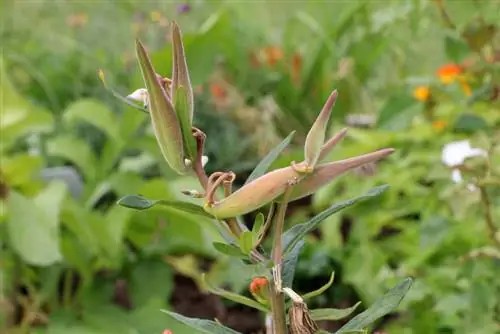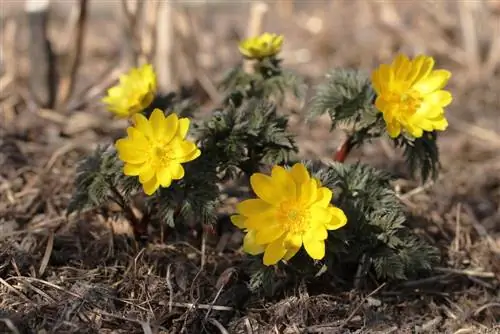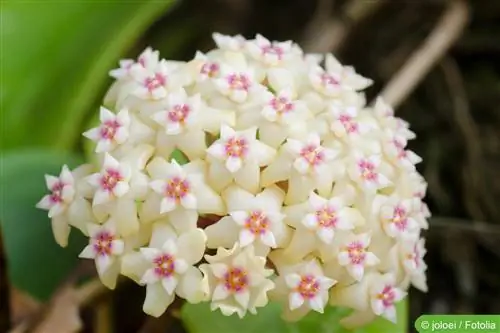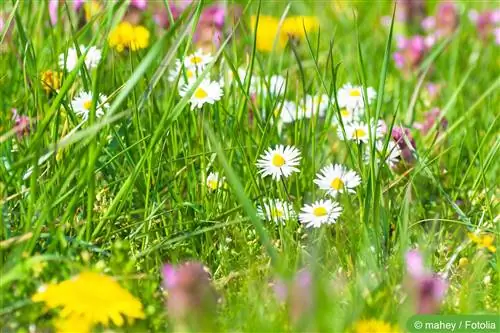- Author admin [email protected].
- Public 2023-12-17 03:39.
- Last modified 2025-01-24 12:45.
The Goldtaler plant, also called coastal beach star, ducat flower, gold coin or beach star, belongs to the plant genus Pallenis from the Asteraceae family. The botanical name of the species is Pallenis maritima. Synonyms are Asteriscus maritimus or Bubonium maritimum. Their homeland is the western and central Mediterranean region. There you can find the pretty plants in the wild on coastal strips. In this country, the Goldtaler is a popular plant for balcony boxes, hanging baskets or summer borders. Not only does it thrive in a group, but it is also a summer eye-catcher as a solitary plant.
Care
Pallenis maritima is an easy-care plant that is also suitable for beginners. It blooms from late April to October. Its bright yellow flowers are reminiscent of those of sunflowers. To ensure that the ducat flower constantly develops new flowers, you should remove withered flowers.
Location and substrate
The Goldtaler loves the sun. So even the blazing sun during midday doesn't bother him. Since the plant is extremely robust against wind and weather, it is also suitable for balconies that cannot be protected from strong wind or rain. In order for the coastal beach star to thrive, it needs a nutrient-rich substrate. Place the Goldtaler plant in a substrate made of clay and sand or in conventional bedding plant or balcony potting soil. Alternatively, it can also be planted in a loose substrate with clay. The pH value should be between 5 and 6.

In order for the Goldtaler plant to develop well, it needs a lot of space. The planting distance should therefore be a good 20 centimeters. The plant density per square meter is given as 14 to 16 plants. If Pallenis maritima is combined with other plants in the balcony box, then you should definitely make sure that you do not plant any delicate or not so vigorously growing plants in the vicinity. Because these plants rarely have a chance against the dominant Goldtaler.
Pouring
Keep the substrate sufficiently moist, but avoid waterlogging, as the plant cannot tolerate this. Like overwatering, this can lead to fungal development and root rot. And both can kill the plant.
Tip:
Place a drainage layer made of potsherds or gravel at the bottom of the planter so that excess water can drain easily through the drainage holes in the balcony box.
If the ducat flower is cultivated in a pot, it needs drainage holes so that excess water can drain away. If this accumulates in the saucer, it must be removed so that the plant does not get its feet wet.
Fertilize
To promote growth and flower formation, you should fertilize the Goldtaler plant weekly with a complete fertilizer in the first few weeks after planting. You can then increase the interval between fertilizer applications, but it should not be longer than two weeks. Here it is better to fertilize more than too little. The fertilization period ends at the end of August / mid-September so that the plant can prepare for winter rest.
Wintering
Pallenis maritima is perennial but not hardy. That's why she has to spend the cold season indoors. The ideal winter quarters are
- bright
- frost-free
- cool
Nevertheless, the temperature at the winter location must not fall below ten degrees Celsius. The ducat flower is put away before the first frost. The move takes place best when the temperatures are around ten degrees Celsius at night.
Implement

It is best to move the ducat flower and the balcony box into its winter quarters. If the boxes are needed for winter decoration on the balcony, you can also move the plants into smaller pots. So that the plants can get used to their new home, you should do this a good week before the move. This gives the balcony flowers enough time to take root again.
Winter Care
The Goldtaler plant does not need any special care during winter rest. It is important that you reduce the care measures. No fertilization will be carried out until it is cleared out next spring. The coastal beach star also needs less water during the cold season. Although the substrate should not dry out completely, it can still be very dry. It's best to water the plant little by little.
Protection from pests
In summer, the ducat flower is susceptible to aphids. The best way to protect the plant in winter is to regularly check it for pest infestation. Furthermore, the winter quarters must be ventilated regularly on frost-free days to prevent pest infestation.
Start of the outdoor season
Since the Goldtaler plant cannot tolerate frost, the outdoor season begins in mid-May after the Ice Saints, when night frosts are no longer expected. So that it thrives luxuriantly in the coming season and develops many flowers, you should cut the Goldtaler back before clearing it out. Be generous and shorten the plant by a third. So-called horny shoots, i.e. extremely long, thin shoots that have formed during overwintering, are completely removed. They do not form flowers and only take energy from the plant that it actually needs to form flowers.
Plan getting used to time
Although the Goldtaler loves the sun, he has to get used to it again after the winter rest. That's why you shouldn't put the plants in the blazing sun in the first few days of the outdoor season. It is ideal if you clear out the Goldtaler plant on a warm but cloudy day.
Propagate
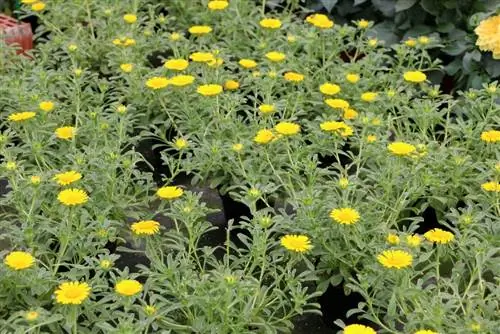
The Goldtaler plant is propagated via cuttings. The best time to take cuttings is between November and March. Ideally, however, you cut the cuttings before the plants go into winter quarters. This means the plants' winter rest is not disturbed. If you have gold coins of different ages available, then take cuttings from plants that have already overwintered, as these mother plants are more robust.
Tip:
Make sure that the cuttings do not have any flower buds, as these rob the cuttings of too much energy.
The cuttings obtained are simply placed in potting soil. Keep the substrate moist over the winter, but not too wet, as this will harm the offspring. Choose a bright location without direct sunlight for the cuttings. The optimal temperature for the development of cuttings is between 12 and 15 degrees Celsius. In addition, a glass lintel promotes their growth. Ventilate the glass lintel once a day to prevent fungi from forming due to the moist air underneath.
Tip:
If strong young plants have formed, you should trim them so that they grow bushier.
The young Goldtalers, like the mother plants, come outdoors in mid-May after the Ice Saints. They can be placed in the garden bed or in a planter until next winter. From this point on they are cared for like adult ducat flowers.
Diseases and pests
Diseases rarely occur with the Goldtaler plant. As a rule, the plants become ill due to care errors. When the soil is waterlogged and the substrate is too wet, root rot occurs because the roots can no longer absorb oxygen. As a result, they, and very quickly the entire plant, die. Drain holes and a drainage layer prevent excess water. If the substrate is still too wet for a long period of time, the plants must be moved to a dry substrate. In this case, you should also water the Goldtaler plant very carefully.
As far as pests go, aphids are Goldtaler's biggest enemy because they feed on the sap of the plants. Since aphids multiply explosively, you should remove them as soon as they appear. If the colony has already spread significantly, cut off the affected parts of the plant generously. You should also separate infected plants if possible.


